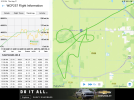ateamer
Pattern Altitude

One dead, one hospitalized after small plane crashes in Fort Pierce
It happened around noon near the intersection of Orange Avenue and Sneed Road in Fort Pierce.
From FlightAware, appears to be a plane from Aviator College at Ft. Pierce (KFPR).




